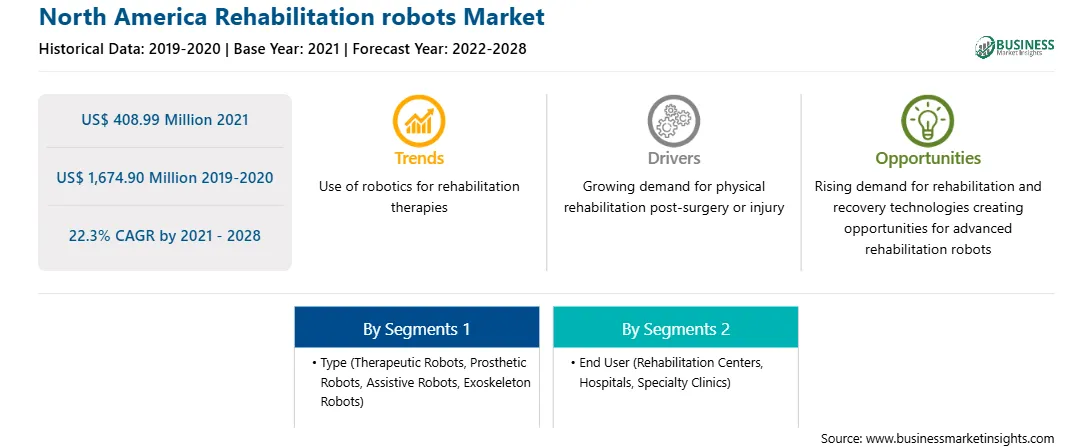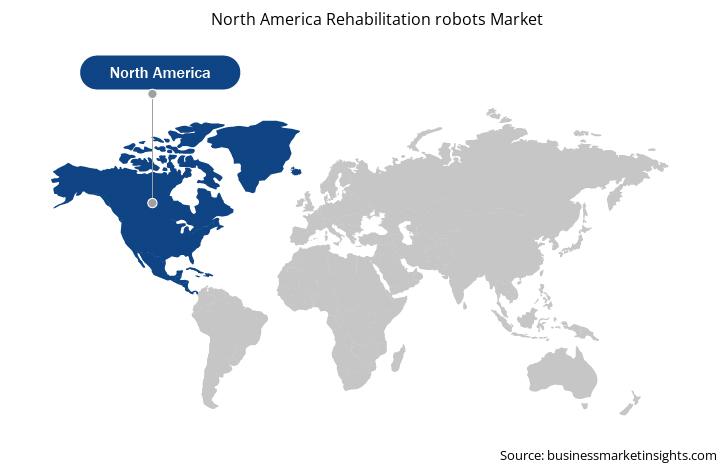The US, Canada, and Mexico are the major economies in North America that have witnessed growth. North America consists of three major countries, namely the US, Canada, Mexico. The growth of the market in countries such as the US and Canada is prominently driven by rising prevalence of stroke, anxiety, limb deformities, and growing launches of advanced technologies. Moreover, increasing awareness regarding benefits served by rehabilitation robots’ are also estimated to offer a favorable environment for growth of the North America rehabilitation robots market during the forecast period. Rehabilitation robot is an automatic machine designed to increase movement in persons with impaired physical functioning. In the field of the healthcare and medical the research and developments are rising rapidly across the world. The increasing aging population and a growing number of stroke rendering people immobile are among the significant factors driving the demand from the rehabilitation robot’s market.
The North American region is highly affected due to the outbreak of the Covid-19 pandemic. Countries such as the US and Canada reported the most significant numbers of COVID-19 positive cases. The US registered the highest number of deaths due to the COVID-19 pandemic. The chaotic situation was created in the medical industry across the countries, increased demand for COVID diagnostics and therapeutics have dramatically increased in the hospitals. In the US, due to an increasing number of infected patients, healthcare professionals and leading organizations distract the flow of healthcare resources from research & development to primary care, which slows down the process of innovation. In addition to the physical or cognitive state, psychological health acts as an indicator of the surviving population's quality of living. Nevertheless, considering the rapid spread of COVID-19, several healthcare services are looking for strategies to promote physical distancing and enhance healthcare procedures. Physical distancing and isolation measures are adopted worldwide. The supply schedule and distribution channel have also been disrupted during these months, and manufacturers are facing many backorders on many products. Therefore, it is likely to slight negative affect on the rehabilitation robot market due to the abovementioned points. In addition, the COVID-19 pandemic is perplexing healthcare institutions in the region with unprecedented operational and clinical challenges. Moreover, the shift of priorities from rehabilitation robots to coronavirus diagnosis and treatment devices are leading to a decline in robots manufacturing systems.

Strategic insights for the North America Rehabilitation robots provides data-driven analysis of the industry landscape, including current trends, key players, and regional nuances. These insights offer actionable recommendations, enabling readers to differentiate themselves from competitors by identifying untapped segments or developing unique value propositions. Leveraging data analytics, these insights help industry players anticipate the market shifts, whether investors, manufacturers, or other stakeholders. A future-oriented perspective is essential, helping stakeholders anticipate market shifts and position themselves for long-term success in this dynamic region. Ultimately, effective strategic insights empower readers to make informed decisions that drive profitability and achieve their business objectives within the market.

| Report Attribute | Details |
|---|---|
| Market size in 2021 | US$ 408.99 Million |
| Market Size by 2028 | US$ 1,674.90 Million |
| Global CAGR (2021 - 2028) | 22.3% |
| Historical Data | 2019-2020 |
| Forecast period | 2022-2028 |
| Segments Covered |
By Type
|
| Regions and Countries Covered | North America
|
| Market leaders and key company profiles |
The geographic scope of the North America Rehabilitation robots refers to the specific areas in which a business operates and competes. Understanding local distinctions, such as diverse consumer preferences (e.g., demand for specific plug types or battery backup durations), varying economic conditions, and regulatory environments, is crucial for tailoring strategies to specific markets. Businesses can expand their reach by identifying underserved areas or adapting their offerings to meet local demands. A clear market focus allows for more effective resource allocation, targeted marketing campaigns, and better positioning against local competitors, ultimately driving growth in those targeted areas.

The rehabilitation robots market in North America is expected to grow from US$ 408.99 million in 2021 to US$ 1,674.90 million by 2028; it is estimated to grow at a CAGR of 22.3% from 2021 to 2028. Rehabilitation robotics is a relatively young and rapidly growing field, with an increasing penetration into the clinical environment. Robotic therapy has shown its effectiveness on motor recovery, but its effectiveness on cognitive recovery is not investigated completely. The most widely studied rehabilitation robots are the MIT-MANUS and its clinical successors, the InMotion2 and InMotion ARM robots (Interactive Motion Technologies, Watertown, MA). Therapy comprises repetitive goal-directed and planar reaching tasks that emphasize shoulder and elbow movements. The low-impedance controller of the InMotionARM is highly compliant when interacting with the client's arm, like hand-over-hand assistance from a therapist during conventional therapy. Although the InMotionARM can provide the passive, active-assistive, active, and resistive modes of therapy, the majority of studies investigated the effects of active-assistive robotic therapy on motor recovery after stroke. Thus, the preference for highly advanced therapy would offer lucrative opportunities for the growth of the medical robot market.
The North America rehabilitation robots market is segmented into type and end user. Based on type, the rehabilitation robots market is segmented into therapeutic robots, assistive robots, exoskeleton robots, and prosthetic robots. The exoskeleton robots segment held the largest share of the market in 2020. Based on end-user, the rehabilitation robots market is segmented into hospitals, rehabilitation centers, and specialty clinics. The rehabilitation centers segment held the largest share of the market in 2020.
A few major primary and secondary sources referred to for preparing this report on the rehabilitation robots market in North America are company websites, annual reports, financial reports, national government documents, and statistical database, among others. Major companies listed in the report are Bionik; Cyberdyne Inc.; DIH Medical; Ekso Bionics Holdings Inc; Kinova Inc; Myomo Inc; Rewalk Robotics Ltd; Rex Bionics Ltd; and Toyota Motor Corporation.
The North America Rehabilitation robots Market is valued at US$ 408.99 Million in 2021, it is projected to reach US$ 1,674.90 Million by 2028.
As per our report North America Rehabilitation robots Market, the market size is valued at US$ 408.99 Million in 2021, projecting it to reach US$ 1,674.90 Million by 2028. This translates to a CAGR of approximately 22.3% during the forecast period.
The North America Rehabilitation robots Market report typically cover these key segments-
The historic period, base year, and forecast period can vary slightly depending on the specific market research report. However, for the North America Rehabilitation robots Market report:
The North America Rehabilitation robots Market is populated by several key players, each contributing to its growth and innovation. Some of the major players include:
The North America Rehabilitation robots Market report is valuable for diverse stakeholders, including:
Essentially, anyone involved in or considering involvement in the North America Rehabilitation robots Market value chain can benefit from the information contained in a comprehensive market report.